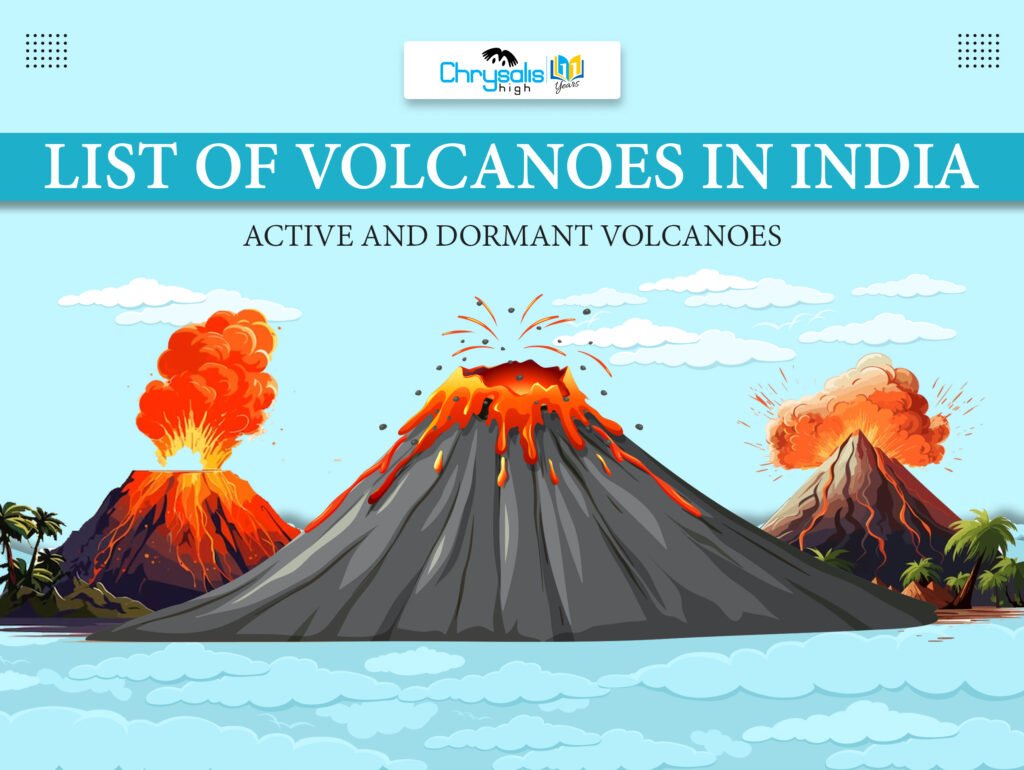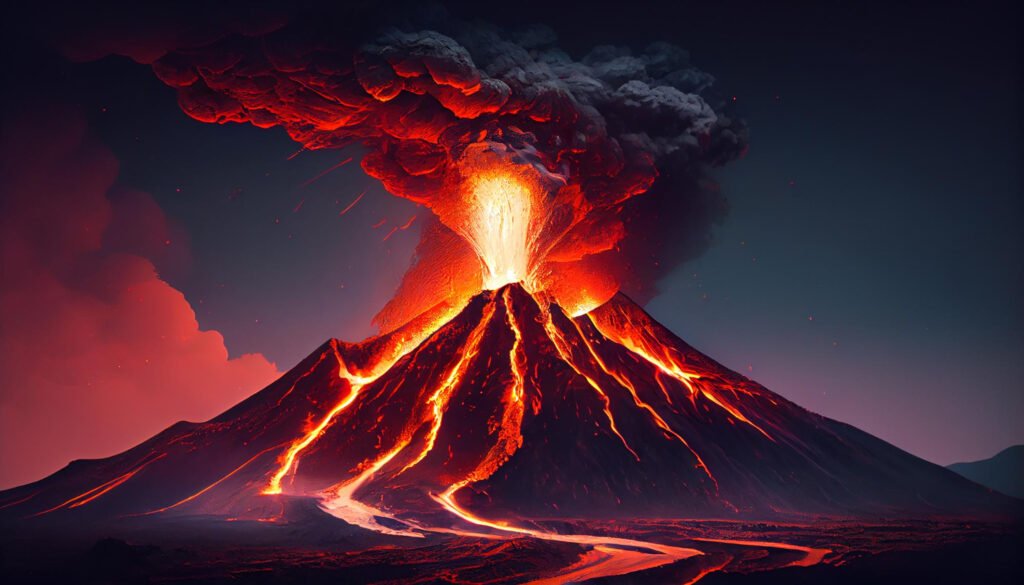
Introduction
Volcanoes in India can be fascinating and sometimes a bit dangerous. They are like nature’s fire-living mountains. In this article, we will explore the volcanoes in India, both the active ones and those that are taking a long nap. Learning about these volcanoes can help us understand our country’s geological wonders and the potential risks that may occur in the future. So, let’s dive into the world of Indian volcanoes to know which ones are active and which are just resting.
What is a volcano, and how are they formed?
A volcano is like a mountain that can sometimes discharge hot, melted rock, ash, and gases coming out from the inside of the Earth. These discharges can be powerful and create lava flows, ash clouds, and even explosions.
Volcanoes are formed when there is a crack or opening in the Earth’s crust, which is like the outer shell of our planet. Inside the Earth, there’s a layer called the mantle, and sometimes, the hot, molten rock from the mantle called magma pushes its way up through these cracks in the crust. When this magma comes out of the Earth’s surface, it forms a volcano. However, as the volcano discharges again and again, it can grow taller and form the familiar cone shape. Also, a volcano is like a mountain made of hot, melted rock from inside the Earth that sometimes bursts out.
Different types of volcanoes
1. Shield Volcanoes:

Shield volcanoes are like big, gentle giants among mountains. They are huge, wide, and have a shape that looks like a warrior’s shield, hence it is named as a shield. These volcanoes are not very sharp and are formed by the slow and steady flow of lava. Unlike explosive volcanoes that can discharge with lots of fire and ash, shield volcanoes typically have a breakout with lava flowing out slowly. They can be found in different parts of the world and are known for their peaceful but impressive beauty.
2. Stratovolcanoes (Composite Volcanoes):
Stratovolcanoes are also known as composite volcanoes. These are big mountains that are made of layers of different materials. These volcanoes are pretty tall and have a classic cone shape like you might draw a volcano in a picture. Strato or composite are made up of layers of lava, ash, rocks, and other stuff that comes out of the volcano during discharge. These layers can come by over time, making the volcano grow taller and taller. Stratovolcanoes can be quite powerful and sometimes have big explosions that shoot out hot lava, ash, and gases. They can also produce pyroclastic flows, which are super hot and fast-moving mixtures of ash, rocks, and gas that flow down the volcano’s sides during an eruption.
3. Cinder Cone Volcanoes:
The cinder cone volcanoes are small, steep mountains made of rocks and ash. These are created when there’s a volcanic discharge. These volcanoes tend to be relatively short and have a simple, cone-like shape. They form when hot molten rock, called lava, shoots out of the volcano and cools quickly in the air. This causes the lava to break into tiny pieces and then fall back to the ground, building up the cone over time. Also, Cinder cone volcanoes are usually not as big or as dangerous as some other types of volcanoes, but they can still discharge and cause problems for nearby areas.
4. Lava Domes (Volcanic Domes):
The Lava domes are also known as volcanic domes. These are hills or mounds formed by the slow and thickening flow of lava from a volcano. As discharge ash and rocks into the air, lava domes are created when molten lava flows out of the volcano and piles up over time. Hence, the lava that makes up domes is very thick and sticky, which means it doesn’t flow far from the volcano’s vent. Instead, it builds up near the vent, creating a mound. Lava domes can be quite dangerous because pressure can build up inside them, potentially leading to explosive eruptions. Here, lava domes are like hills made of thick lava that slowly pile up near the top of a volcano.
List of Volcanoes in India
Here’s a simple table listing some of the volcanoes in India:
| Volcano Name | Location | Activity Status |
| Barren Island | Andaman and Nicobar Islands | Active, Active since 2017 |
| Narcondam Island | Andaman and Nicobar Islands | Dormant (Last eruption 1681) |
| Baratang Island | Andaman and Nicobar Islands | Not highly active but still exhibit, Mud volcanoes (Not very active) |
| Dhinodhar | Gujarat | Extinct (Around 500 million years ago) |
| Dhosi Hill | Haryana | Dormant (Around 750 million years ago) |
| Tosham Hills | Haryana | Extinct (Around 732 million years ago) |
| Loktak Lake | Manipur | Supervolcanic caldera (Around 100 million years ago) Unknown |
| Deccan Plateau Volcanoes | Maharashtra, Karnataka | Extinct (Approximately 25 million years ago) |
This table provides a brief overview of some of the notable volcanoes in India, their locations, and their activity statuses.
Active, Dormant, and Extinct Volcanoes in India
Here is the explanation of the volcanoes Active, Dormant, and Extinct Volcanoes in India
- Barren Island
Barren Island is a unique island in the Andaman Sea. It is special because it is the only place in India where we find an active volcano. The Andaman and Nicobar Islands include it. This island is about 138 kilometres (86 miles) away from Port Blair, the capital of the Andaman and Nicobar Islands. The volcano on Barren Island has been exploding for a long time, with records of its first outbreak dating back to 1787. It has discharged more than 10 times since then, and the most recent eruption happened in 2020.
- Narcondam Island:
Narcondam Island is situated in the Andaman Sea and is known for its dormant volcano. It is one of the Andaman and Nicobar Islands belonging to India, located approximately 130 kilometres (81 miles) northeast of Port Blair, the capital of the territory. The volcano on Narcondam Island is considered dormant, with its last known outburst recorded in 1681. hence, it is not currently active.
- Baratang Island:
Baratang Island is situated in the Andaman and Nicobar Islands in the Indian Union and is known for its mud volcanoes rather than active volcanic eruptions. These mud volcanoes are not very active and similarly release mud, gases, and sometimes small amounts of lava. Baratang Island is famous for its lush greenery, mangrove forests, and limestone caves. It is always a popular tourist destination, attracting visitors with its natural beauty and unique geological features. The island’s mud volcanoes have a fascinating natural wonder, offering a glimpse into the Earth’s dynamic processes, even though they are not currently active.
- Dhinodhar Hills:
Dhinodhar Hills are a range of hills situated or located in Gujarat, India. These hills were formed due to volcanic activity, but they are considered extinct, and they are not expected to erupt again. They have been stable for a very long time, estimated to be around 500 million years ago. Dhinodhar Hills are known for their unique geological features and are now a part of the landscape.
- Dhosi Hill:
Dhosi Hill is located in the state of Haryana, India. It is an extinct volcano, which means it has not erupted for a very long time and is not expected to erupt again. These hills were formed approximately 750 million years ago due to volcanic activity. Today, they stand as a witness to the geological history of the region.
- Tosham Hills:
Tosham Hills, also situated in Haryana, were shaped by volcanic activity around 732 million years ago. Like Dhosi Hill, Tosham Hills are considered extinct, and there is no current volcanic activity. They are a part of the natural landscape of the region and have remained dormant for millions of years.
- Loktak Lake:
Loktak Lake is a freshwater lake situated in the Indian state of Manipur. It is unique because of its geological origin. Loktak Lake type is a supervolcanic caldera, a very, very long time ago, about 100 million years ago. But the volcanic activity here is so ancient that it’s hard to say if it will ever erupt again. However, it’s important to note that the status of this geological feature is not well-documented, and its current volcanic status remains unknown.
- Deccan Plateau Volcanoes:
The Deccan Plateau in India is located in Central India approximately 25 million years ago. It is a flat region that stretches between the Western and Eastern Ghats mountain ranges. It is south of the Narmada River and is bordered to the north by the Satpura and Vindhya Mountains. This plateau is famous for its volcanic history, with much of its landscape formed by layers of basalt, which is a rock. The volcanic activity that shaped the Deccan Plateau occurred over millions of years, leaving behind a unique geological heritage. Today, it stands as India’s ancient volcanic past, with both dormant and extinct volcanoes contributing to its unique landscape.
Conclusion
In conclusion, India has only one active volcano, Barren Island, in the Andaman Islands, while Narcondam, also in the Andaman Islands, is a dormant volcano. These are the only known volcanoes with recent or historical activity in India. For further information or updates on volcanic activity, consult relevant scientific sources.
Understanding India’s volcanoes, both active and dormant, illuminates the country’s diverse geological wonders. This knowledge deepens our appreciation for the natural processes shaping our environment, highlighting the fascinating blend of beauty and power within Earth’s landscapes. For further exploration of educational content and insights, delve into the resources available on Chrysalis High.
FAQs:
1. How many volcanoes are in India?
India has a limited number of volcanoes, but Barren Island is the most notable active one.
2. Which is the biggest volcano in India?
The biggest volcano in India is Barren Island, located in the Andaman Islands.
3. Which country has the most volcanoes?
Indonesia has the most volcanoes, with over 130 active ones.
4. Which is the largest volcano in the world?
Mauna Loa in Hawaii is the world’s largest volcano by volume and area.
5. Which is the most active volcano in India?
Barren Island in the Andaman Islands is the most active volcano in India.


